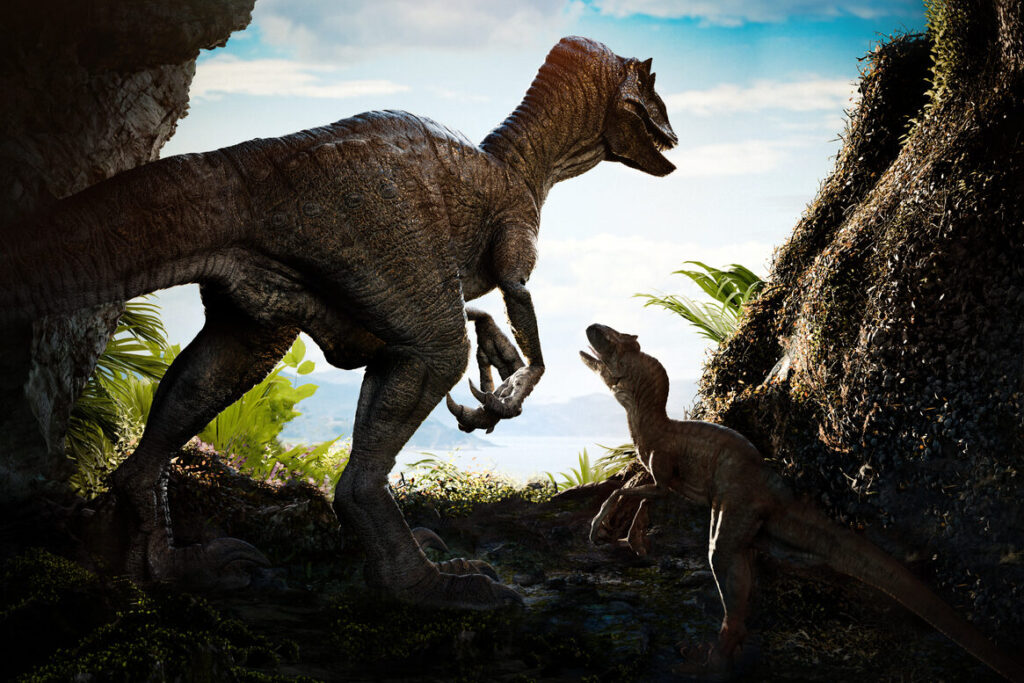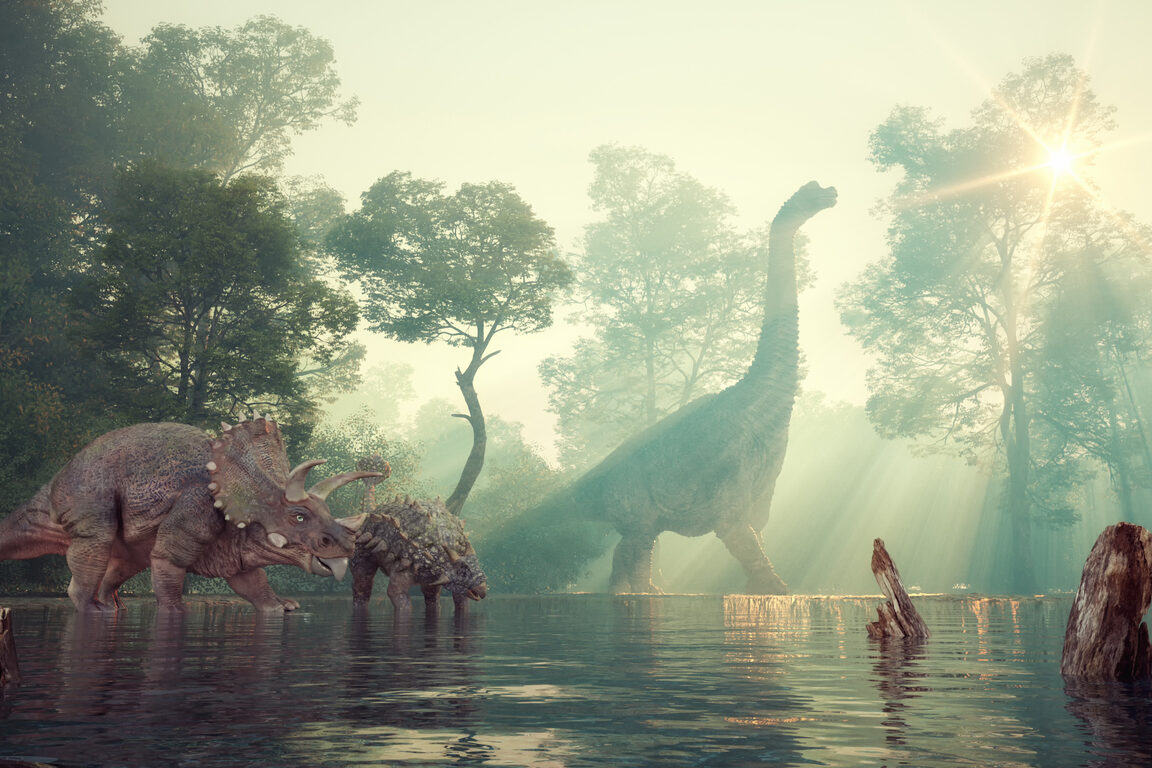1. The Timeline Tells a Different Story

It’s a fascinating thought—early humans walking alongside towering dinosaurs, hunting, gathering, and maybe even running for their lives. But as thrilling as that sounds, science tells a very different story. Dinosaurs roamed the Earth for about 165 million years, from the Triassic Period to the end of the Cretaceous Period, when a massive asteroid impact wiped them out roughly 66 million years ago. Meanwhile, the first ancestors of modern humans didn’t appear until around 6 million years ago, and Homo sapiens—the species we belong to—only emerged about 300,000 years ago. That means there was a gap of tens of millions of years between the last dinosaur and the first humans.
This timeline is one of the most important pieces of evidence against the idea that humans and dinosaurs ever coexisted. Fossil records clearly show that by the time our distant ancestors began to evolve, dinosaurs were long gone. While some prehistoric creatures that lived alongside dinosaurs, like crocodiles and certain fish species, still exist today, the classic dinosaurs—T. rex, Triceratops, Velociraptor—had already vanished. The only direct descendants of dinosaurs that early humans ever encountered were birds, which evolved from small theropod dinosaurs millions of years before humans arrived.
2. The Myths That Keep the Idea Alive

Despite what science tells us, the idea of early humans living alongside dinosaurs is deeply embedded in pop culture and even in some ancient myths. Legends from various cultures describe massive, reptilian creatures, and stories of dragons appear in civilizations all around the world. Some people believe that these myths are based on real encounters with surviving dinosaurs. However, there’s no scientific evidence to support this claim. What’s more likely is that ancient people discovered large fossils and created stories to explain them, leading to the birth of dragon myths and other giant-beast legends.
Another reason the idea persists is its strong presence in movies, books, and television. From The Flintstones to Jurassic Park, the concept of humans and dinosaurs sharing the same timeline has been romanticized and exaggerated for entertainment. Dinosaurs are fascinating, and so are early humans, so combining the two makes for an exciting story. But just because it’s fun to imagine doesn’t mean it’s true. The fossil record, carbon dating, and geological evidence all point to a world where humans and dinosaurs were separated by millions of years, making any real-life encounters impossible.
3. Fossils Don’t Lie

If early humans and dinosaurs had ever crossed paths, there would be clear fossil evidence of their coexistence. Scientists have spent centuries digging up remains of both species, but their fossils are never found together in the same rock layers. Instead, dinosaur fossils are buried in much older geological strata, while human fossils appear in much younger ones. This distinct separation in layers proves that humans and dinosaurs lived in entirely different eras.
In addition, the way fossils are dated provides further confirmation. Methods like radiometric dating allow scientists to determine the age of rocks and fossils with remarkable accuracy. These tests consistently show that dinosaur bones date back tens of millions of years, while human remains only go back a few hundred thousand years at most. If humans had ever encountered dinosaurs, there would be at least some overlap in fossil records—but there simply isn’t any.
4. Birds Are the Closest Link

Even though humans never saw a living dinosaur, we still interact with their descendants every day. Modern birds evolved from a group of small, feathered theropod dinosaurs, and their lineage continues to thrive today. This means that, in a way, we do live alongside dinosaurs—but not the giant, reptilian kind seen in movies. Instead, they’re the robins in our backyards, the pigeons on city streets, and the hawks soaring above.
This connection between birds and dinosaurs is one of the biggest discoveries in paleontology. Fossils of feathered dinosaurs, like Archaeopteryx, provide a clear link between ancient reptiles and modern birds. Even features like hollow bones, wishbones, and certain lung structures are shared between birds and their prehistoric ancestors. So while humans never coexisted with creatures like T. rex, the legacy of dinosaurs is still alive in the animal kingdom around us.
5. Misinterpreted Evidence

Some claims suggest that ancient humans may have recorded sightings of dinosaurs through cave paintings or carved depictions of large reptilian creatures. However, experts argue that these artworks are often misinterpreted. Many of the so-called “dinosaurs” in ancient drawings resemble creatures that did exist alongside early humans, such as crocodiles, large lizards, or even imaginative depictions of mythological beasts. Without proper scientific evidence, these artworks alone cannot prove human-dinosaur coexistence.
Another source of confusion comes from supposed “out-of-place” fossils, where human footprints have been claimed to appear alongside dinosaur tracks. However, upon closer analysis, these cases have been debunked as either natural erosion forming misleading shapes or intentional hoaxes. True fossil records show a clear chronological divide, meaning no scientifically verified human remains or artifacts have ever been found in dinosaur-age rock layers.
6. The Extinction Gap

Dinosaurs didn’t just gradually fade away—they were wiped out in a cataclysmic mass extinction event around 66 million years ago. A massive asteroid impact is believed to have triggered a global climate disaster, causing widespread fires, blocked sunlight, and a drastic temperature drop. This event marked the end of the Cretaceous Period and led to the extinction of nearly all dinosaur species, except for the ancestors of modern birds.
By contrast, early human ancestors like Australopithecus didn’t appear until roughly 6 million years ago, meaning there’s a staggering 60-million-year gap between dinosaurs and humans. Even if some small, dinosaur-like creatures had survived into the early days of mammals, they would have been vastly different from the giant dinosaurs people imagine. The timeline simply doesn’t allow for any chance that humans and dinosaurs ever met face-to-face.
7. Dinosaurs in Popular Culture

Despite the scientific evidence, the idea of humans and dinosaurs coexisting remains popular, largely thanks to movies, books, and television. From adventure stories of prehistoric tribes fighting off dinosaurs to blockbuster films like Jurassic Park, the concept captures the imagination. However, these portrayals are pure fiction, designed for entertainment rather than scientific accuracy.
The continued fascination with dinosaurs in human history might stem from our natural curiosity about Earth’s past. Dinosaurs were the dominant creatures for over 160 million years, shaping ecosystems in ways we are still uncovering. While humans missed out on witnessing these incredible beasts firsthand, their fossils continue to reveal fascinating details about life long before our species ever existed.


